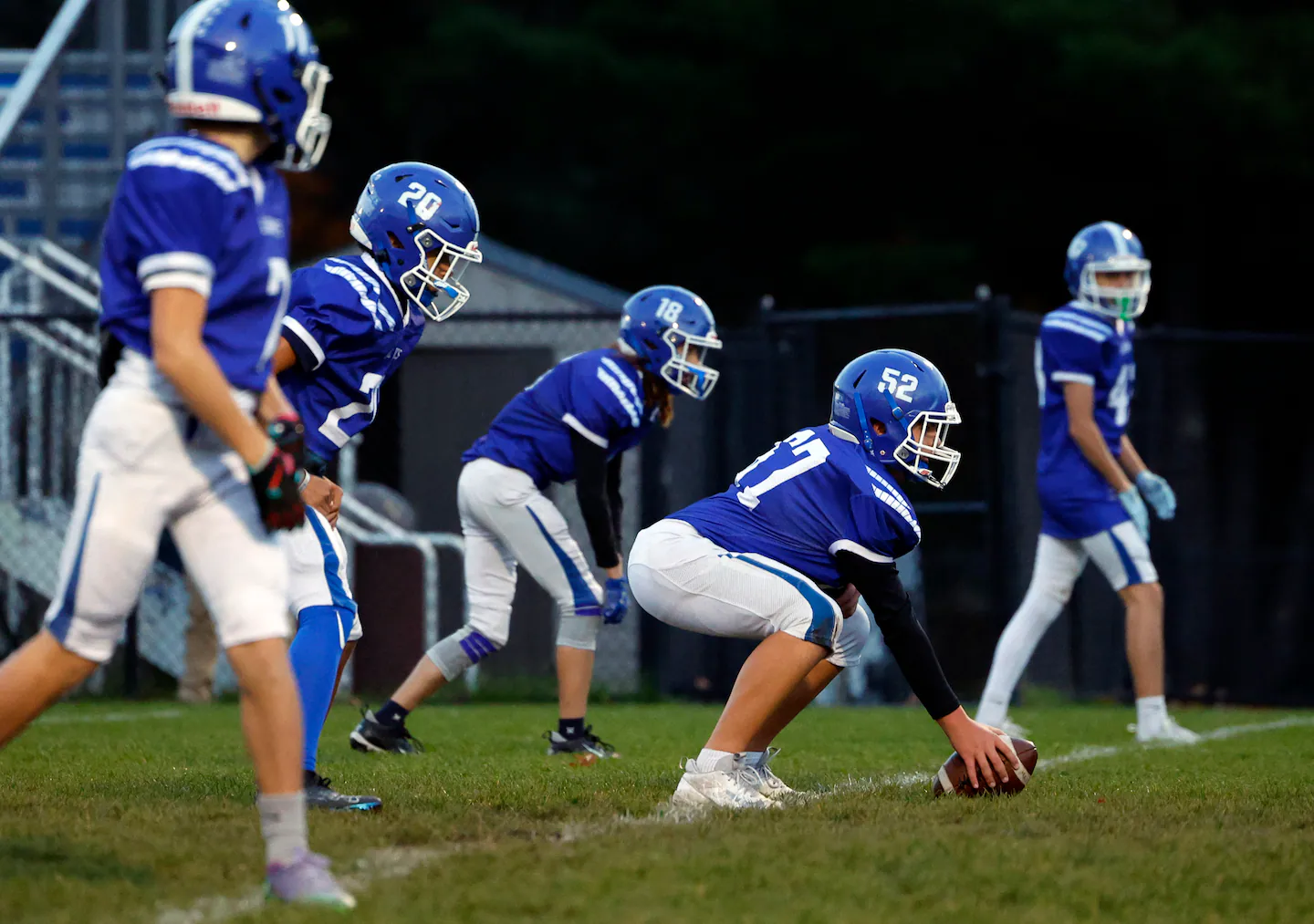Copyright The Boston Globe

“I don’t want to lose my football program,” Kendall said. “And we’re in danger of it.” His school has 388 students, making it one of the largest in the MIAA’s smallest football classification, Division 8. It is one of 34 schools statewide that host a cooperative football program (96 schools are involved in total), taking in a combined seven players from Bromfield and Parker Charter. Kendall had to put his junior varsity season on pause in late October. They were playing 7-on-7 JV games before that, mostly with eighth-graders. He has arrived at a potential solution for small schools in similarly dire straits: They can get behind the eight ball. Eight-player football, that is. It removes two linemen and one skill player from the standard 11-on-11 lineup. It is played on a shorter, narrower field (80 yards by 40 yards) than the traditional kind (100 yards by 53⅓ yards). Games are typically higher-scoring. In a time of shrinking populations and declining school enrollment numbers, especially in rural areas, the option to play the reduced-number version of the game — temporarily or permanently — might allow dozens of Massachusetts teams to keep the sport on campus. Born in the Dust Bowl during the Great Depression in small-town Nebraska, 8-on-8 has flourished recently in both rural Maine and leafy New England prep schools. It has long been a staple in the Midwest, and in football-crazy states such as Texas and California. Once Maine approved it in 10 schools in 2019, the eight-player game “became, very quickly, one of the biggest sports here,” said Steve Bell, president of the Maine Principals Association. Some schools, he noted, have reclassified back to 11-on-11. MIAA executive director Bob Baldwin, whose roots are in Nebraska, said he hadn’t considered eight-player football as a solution in Massachusetts until recently. “As enrollments change, we can’t do things the way we’ve always done,” said Baldwin, noting that lots of kids playing a sport, any sport, is the MIAA’s ideal. “We’re not saying no to any opportunities. And we’re going to put together an objective way to look at those opportunities.” Green-lighting eight-player football would likely have to involve a change in MIAA policy. New sports are added or dropped via a rule change, on a two-year cycle. The first round of votes comes from committees representing all the MIAA sports — even those that would compete for resources and athletes with the sport seeking approval. Kendall sees it as an “old-school, archaic way of doing things. Look at girls’ flag football. You put that in the spring, in theory, you’re taking kids away from softball, lacrosse, and track. You’re never going to get those sports to vote for it.” The MIAA’s next board of directors meeting is Nov. 12. Kendall and several other administrators anticipated a challenge in getting coaches on board. “Eleven-on-eleven is the way it’s always been,” Kendall said. Programs such as “Brockton or Everett, they probably don’t want it. And I get it — they don’t need it. But I want to see small-school football survive.” Milton High coach Steve Dembowski, a board member and former president of the Massachusetts High School Football Coaches Association, said the organization has no official opinion on eight-player football. It hasn’t been discussed, to his knowledge. However, he wouldn’t stand in the way. “We support kids that play football and we support athletes,” Dembowski said. In Nebraska, high schools play with 11, 8 or 6 players based on their participation numbers. They reclassify every two years. Combined, more schools play with eight (111 schools) and six players (34) than they do with 11 (132). Cory Eikmeier, who set the national record for eight-player touchdowns (155) at Dodge (Neb.) High, said he appreciated “not playing every position on the field,” as he would have had to if his school had 11-on-11. The game has “given smaller communities a chance to thrive,” said Nate Neuhaus, assistant director of the Nebraska School Activities Association. “In the Midwest and across the country, football is a big deal. It’s kind of the front porch to your community and your school.” Over the last 15 years, according to National Federation of High Schools participation data, football signups are down 17 percent in Massachusetts compared with 7 percent nationally. Programs everywhere, especially in Central and Western Mass., report safety concerns becayse of low numbers. The Island Cup, the ferry-riding rivalry game held last year at Fenway Park, was canceled this year because Martha’s Vineyard didn’t have enough players to safely face Nantucket. On the North Shore, Manchester-Essex is 6-1 and competing for the Cape Ann League title with 32 varsity players, including co-op students from Rockport. That’s a lot better than seven or eight years ago, when it was stuck around 14. Manchester-Essex athletic director Cami Molinare said she has spoken with neighbors Ipswich and Hamilton-Wenham about the possibility of playing 8-on-8. She would like to have the option right now at the JV level, where Manchester-Essex has canceled six games this season because of safety concerns. “That could be where we’re all headed in a few years,” Molinare said. “I know schools would rather play eight-man football than dissolve their programs completely, and I’m in that same mind-set. “There’s just so much pride and support around football in the community. Losing the program would be devastating. Seeing what’s happening in hockey, with how many teams are co-oping … they don’t want it to happen in football. “I think coaches are aware of that, and they’re starting the conversation. Athletic directors are certainly aware of it and having conversations with one another to come up with any sort of creative solution. I think this solution makes sense.” South of Boston, the Holbrook-Avon co-op started the season late because of low turnout. Injuries have since trimmed a roster of 24 players to 18. Essentially, coach Fran Cass said, the Bulldogs (0-5) are “playing a season to give a few kids a varsity experience.” Cass would rather not downshift. “Eight-man, I’d hate to see it,” he said. “I love 11-man. But it would be better than nothing. And it would be better than flag football.” Ultimately, Cass concluded, “I’m not opposed to it. It does open up an option for programs that are struggling.” Kendall said several other teams in Central Mass. — he mentioned David Prouty High, Littleton, Lunenburg, Murdock, and Worcester Tech — and Western Mass. are in similar situations. A former area champion, North Middlesex, which won six state titles from 1989-95, has been reduced to a co-op partner with Groton-Dunstable. Boston Public Schools athletic director Avery Esdaile said he isn’t sure eight-player football would have appeal among the city’s seven programs — all but one of which are hosting a co-op — but called it a “forward-thinking” solution that “has some merit.” “Our numbers are pretty stable this year,” Esdaile said. “In terms of worrying about not being able to play games, we’re not facing any of that. But things change with time.” The NEPSAC has had an eight-player division since 2019. The game has thrived at Holderness School in New Hampshire, resurrecting a once-dominant 11-on-11 program that saw falling enrollment and other sports sap its strength. “It’s allowed us to continue to play football and has been a really positive experience,” said Rick Eccleston, a former Holderness athletic director and current assistant football coach. “It’s the same exact game, just three fewer players.” It has little history in Massachusetts. A few schools in the Berkshires played eight-player football decades ago. A six-player league flourished on the North Shore in the postwar years — Story High, the predecessor to Manchester-Essex, was a power — but folded in the ‘60s. Bill MacEachern, Story High’s quarterback, recalled in a 2005 Globe story that a different number of players didn’t alter their love of the sport: “It was simply six guys trying to kill you instead of 11.”



